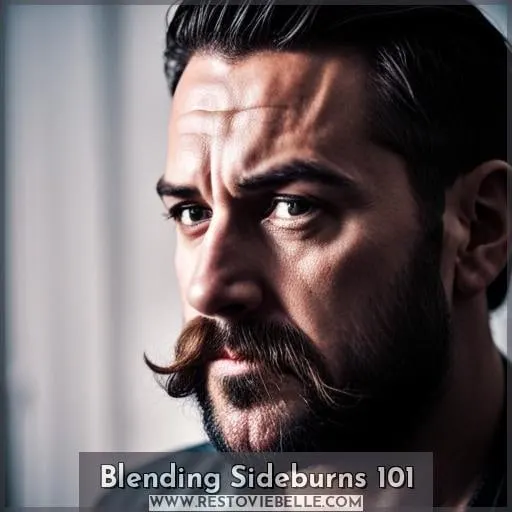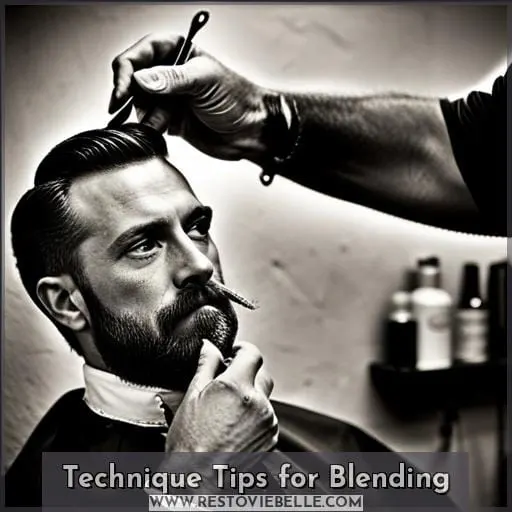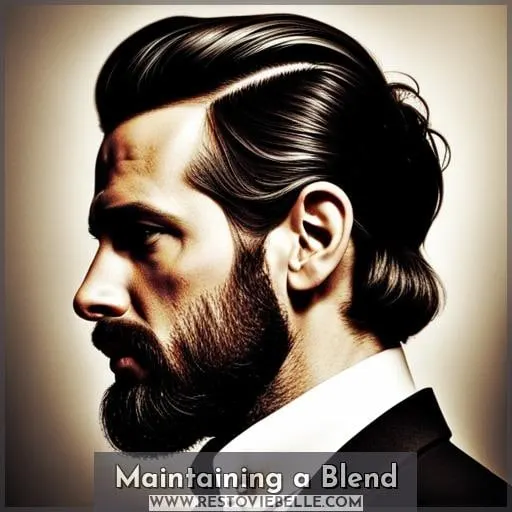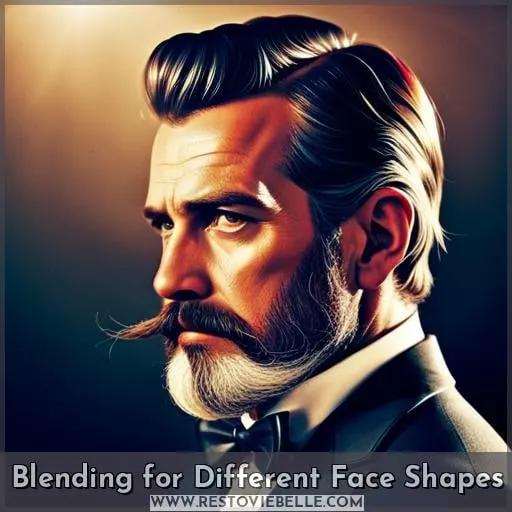This site is supported by our readers. We may earn a commission, at no cost to you, if you purchase through links.
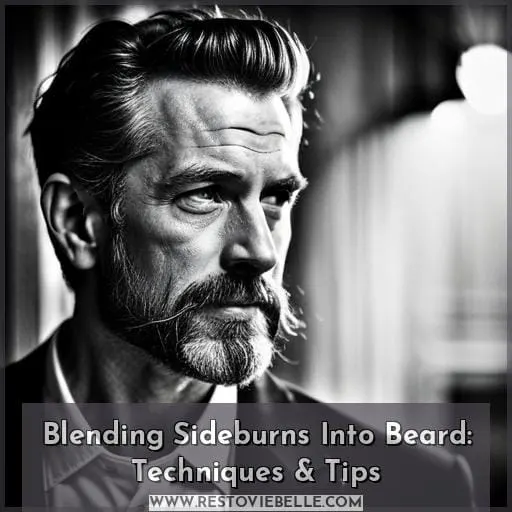 Growing a full beard takes skill—from proper grooming to blending in those sideburns seamlessly.
Growing a full beard takes skill—from proper grooming to blending in those sideburns seamlessly.
You want facial hair that perfectly frames your jawline and cheekbones. With the right trimmer and technique, sculpt a beard that accentuates your facial shape.
Follow simple tips to blend sideburns into your beard for a polished style that says ‘power’ and ‘mastery.
Table Of Contents
Key Takeaways
- Master sideburn blending through tapering and fading techniques.
- Frame the face by maintaining well-trimmed and blended sideburns.
- Use the right tools, such as the Norelco Multigroom Trimmer and Bevel Beard Trimmer, for effortless blending.
- Avoid common blending mistakes, such as overblending and a lack of consistency in maintenance.
Blending Sideburns 101
You’ll master sideburn blending once you understand the basics of tapering and fading techniques that seamlessly integrate facial hair with hairstyles.
When maintained properly, sideburns frame the face, so keeping them trimmed and blended is key for an integrated style. Whether you sport a full beard, mustache, or other facial hair look, precision grooming of your sideburns ties everything together.
The most common approach is tapering the sideburns from thicker at the bottom to thinner towards the top. You can create a soft blend by holding your trimmer at a 45 degree angle and using gentle, short strokes from bottom to top.
For a more defined look, keep the taper tight on the cheekline and hairline. And for extra styling options, try a beard fade that transitions the length gradually up the sideburns.
No matter what tools or techniques you use―trimmers, outliners, guards, freehand sculpting―the goal is crafting seamless harmony between your hairstyle and facial hair shape. So take the time to trim, check, tweak, and perfect the integration. With practice, you’ll be tapering and blending your sideburns like a pro for a polished, liberated look.
Tools for Blending Sideburns
When it comes to blending sideburns into your beard, having the right tools is essential.
Two tools that can help you achieve a seamless blend are the Norelco Multigroom Trimmer Hard Case and the Bevel Beard Trimmer.
The Norelco Multigroom Trimmer Hard Case provides protection for your trimmer while traveling, ensuring it stays in top condition.
On the other hand, the Bevel Beard Trimmer offers precision and control for achieving clean lines and well-defined mustaches.
With these tools at your disposal, you’ll be able to effortlessly blend your sideburns into your beard for a polished look.
Norelco Multigroom Trimmer Hard Case
View On Amazon
To achieve a seamless blend when blending your sideburns into your beard, one essential tool to have is the Norelco Multigroom Trimmer Hard Case. This protective case is specially designed to keep Philips Norelco trimmers safe from damage.
Made from durable black nylon, it has a soft interior lining that prevents scratches. With enough space for your trimmer, charger, and accessories, it makes storage and transport easy while reflecting your sophisticated taste.
- Shockproof and water resistant
- Perfect fit for Norelco trimmers
- Extra storage for accessories
- Protective soft lining
- Case only, trimmer not included
- May not fit other models
Bevel Beard Trimme
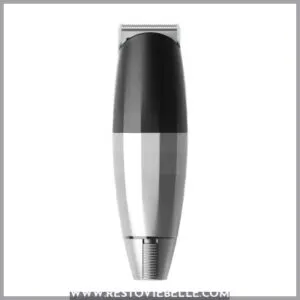
You need the Bevel Beard Trimmer for its precision and salon-like results when blending your sideburns into your beard from home. This sleek, black cordless trimmer lets you shape facial hair with finesse thanks to its adjustable blade and 6-hour battery.
Designed by professional barbers for the ultimate control, it sculpts goatees and mustaches cleanly without irritation from home.
- Precision and control
- Salon-quality results
- Long battery life
- May not suit all beard types
- Lacks attachments
Technique Tips for Blending
Starting your blending off with light, controlled strokes of the trimmer held at a 45 degree angle to your face, you’ll achieve a smooth transition into your beard.
Here are some technique tips for blending:
- Trimmer Angles:
- Holding the trimmer at a 45-degree angle helps ensure that you’re cutting the hair evenly and smoothly.
- This angle allows for better control and precision as you blend.
- Find the sweet spot where your facial hair starts to get cut by going over your sideburns until you feel resistance from the trimmer.
- This will help determine how short or long you want to fade into your beard.
- To create clear boundaries between your sideburns and beard, use an attachment-free trimmer on clean skin along with precise lines drawn from ear down to mouth on each cheek.
- Gradually taper out by increasing guard length in increments of 2 millimeters while holding it against different parts of face such as mustache area, all over jawline, bottom part near ears.
By following these techniques, not only will avoid common mistakes but also achieve seamless blend between sideburns into full grown beards creating more defined look overall without any harsh transitions noticeable.
Common Blending Mistakes
One common mistake when blending your sideburns into your beard is taking off too much hair initially.
It’s easy to get overzealous with the trimmer and cut the sideburns too short right away. This can leave you with a jarringly short sideburn length compared to the rest of your beard.
Instead, taper down the sideburn length gradually, using different clipper guard lengths to slowly transition into your beard’s length.
Start longer than you think you need – you can always take more off, but putting hair back on is impossible! Using the right guard and taking your time is key to avoiding uneven sideburn tapering. Precision errors like taking too much off at once can also create noticeable length discrepancies between sections.
It’s vital to keep checking your blending progress frequently with a mirror, gradually tapering down in stages rather than all at once.
Overblending is another concern if you trim too far down into your beard line instead of tapering from longer sideburn hair. Mastering guard selection and progressing in stages helps create a seamless blend into your ideal beard style.
Caring for Blended Sideburns
Maintaining your new blend involves regularly using quality beard care products to moisturize skin and tame frizz between trims.
- Moisturize with beard oil daily, focusing on the skin underneath.
- Use a boar bristle brush gently in direction of growth.
- Clean trimmers after each use to maintain sharpness.
Caring for blended sideburns requires consistency with moisturizing and brushing to condition skin and hair, retaining a polished shape. Beard oil containing ingredients like jojoba, argan, or grapeseed oil will nourish hair follicles and prevent dryness.
Gently brushing with a quality boar bristle brush stimulates blood flow to promote growth while training hairs to lie neatly.
Keeping your tools in top shape ensures each trim reaches skin evenly, avoiding patchiness. Wipe blades clean and lubricate after each use. Store in a dry place to prevent corrosion.
Following this simple routine of moisturizing, brushing, and maintenance will help you achieve seamless, healthy sideburn blending.
Maintaining a Blend
You’ll need to trim and detail your blended sideburns every few days to keep their shape and blend with your beard. Daily maintenance is essential for maintaining a seamless blend between your sideburns and the rest of your facial hair.
Use a quality trimmer, such as the Andis Slimline Pro Li Clipper or Bevel Beard Trimmer, for precision trimming. Start by brushing your beard in the direction of growth with a comb, then use short, light strokes at a 45-degree angle to fade from the bottom of your ear up towards the top of your sideburn.
To ensure that you maintain an even blend throughout different seasons when hair growth may vary, make seasonal adjustments as needed. Depending on how quickly or slowly you grow facial hair during certain times of year, you may need to adjust how frequently you trim and detail.
For product recommendations that can help enhance blending results while promoting healthy skin and hair growth:
- Consider using Norelco Multigroom Trimmer Hard Case for protective storage;
- Kent Apsley Fine Wide Tooth Pocket Comb for smooth gliding through all types;
- ZilberHaar’s Beard Grooming Brush Straightens Beard Promotes Growth which uses natural boar bristles;
- Philips Norelco QT4050 Vacuum Trimmer offering an integrated vacuum system capturing cut hairs mess-free
Take inspiration from celebrity blends like Ryan Reynolds’ well-blended sideburns into his full beard or David Beckham’s creative blending techniques where he fades his stubble seamlessly into longer length beards.
By following these tips on daily maintenance along with making necessary seasonal adjustments based on individual needs while incorporating recommended products inspired by celebrity blends will allow anyone seeking liberation within grooming routines achieve power over their appearance through mastering creative blending techniques resulting in polished-looking blended sideburns flowing harmoniously into their beards.
Achieving a Seamless Blend
To achieve a seamless blend, start by gradually decreasing the length of your sideburns as you move up towards your beard. This gradual transition ensures a smooth and natural integration between the two.
When blending, it’s important to consider your face shape and create a look that complements your features. Precision is key in achieving stylish sideburns that seamlessly flow into your beard.
Begin by trimming down the length of your sideburns using an electric trimmer with adjustable combs or guards. Start with a longer setting and work towards shorter lengths as you move upwards towards the beard area.
When blending, hold the trimmer at around 45 degrees angle to ensure precision while maintaining control over how much hair you remove from each pass. Take care not to blend too high or too low on both sides of your face for symmetry.
Remember that everyone’s face shape is unique, so adjust accordingly based on what suits you best – whether it be creating sharp angles for square faces or softer curves for rounder faces.
By following these tips and techniques for achieving seamless integration between sideburns and beards through precision blending, you can confidently rock stylish facial hair with ease.
Blending for Different Face Shapes
When blending sideburns into your beard, consider the different face shapes to achieve a seamless transition.
-
Oval Face Blending
- Angle trimmer on a diagonal from sideburn point to jawline
- Use guard combs to taper beard length gradually
- Leave more volume around the jawline
-
Square Face Tips
- Soften corners by tapering sideburns on a diagonal
- Avoid very short fades that accentuate jawline
- Leave more length along the jawline
-
Round Face Techniques
- Create definition using shorter fades
- Taper sideburns tighter to the face
- Angle trimmer to contour the face
-
Heart Shape Blend
- Wider sideburns help balance forehead width
- Taper beard closely along the jawline
- Leave chin area fuller
-
Diamond Face Tricks
- Angle trimmer to widen appearance of cheekbones
- Taper beard to balance facial width
- Soften sideburns; don’t over-define
When fading sideburns for different faces, adjust techniques to flatter natural features.
Troubleshooting Problems
If your blend looks uneven, double check your technique and tools to address any issues.
An uneven blend typically stems from inconsistencies in trimmer stroke direction, pressure, speed, or holding angle. Ensure you maintain the proper 45-degree angle as you taper the sideburn downward into the beard using short, light, downward strokes.
Check that your trimmer blades are sharp, the battery is charged, and the guards are correctly sized and firmly secured. Replace dull blades promptly and recharge batteries fully to ensure consistent trimmer power and cutting efficacy.
Make certain the guards used properly correspond to the sideburn and beard lengths for seamless blending.
For line discrepancies, carefully follow facial lines with precision. Define clear boundaries above cheekbones and below necklines first before tapering the fade itself. Use a comb to guide the trimmer smoothly across transition zones between shaved skin and bearded regions.
Assess areas of length variation or uneven spots. Go back over them with slight adjustments to trimmer guard sizes and stroke direction to even out the blend. Don’t trim more than necessary; slight length discrepancies will relax over time.
Frequently Asked Questions (FAQs)
What’s the best style of sideburns to complement my face shape?
To find the best style of sideburns to complement your face shape, consider:
- Shorter and more tapered sideburns for round faces.
- Longer and fuller styles for angular or square faces.
Experiment to find what suits you best!
How often should I maintain my sideburn blend?
To maintain a seamless sideburn blend, trim and fade your sideburns every two days. This consistent upkeep ensures that your beard remains polished and sharp, allowing you to showcase your mastery of grooming techniques.
Is it easier to blend sideburns on curly or straight hair?
Blending sideburns is easier on straight hair. Curly hair can spring back after trimming, hiding your precision work.
Focus on taking your time, using guards, tapering gradually, and checking angles often to achieve a smooth blend on curls.
Can I fade my sideburns into my beard instead of blending?
Yes, you can absolutely fade your sideburns into your beard for a stylish and seamless look.
By gradually decreasing the length of your sideburns as they blend into your beard, you’ll achieve a polished and well-groomed appearance.
What products can help my blend last longer between trims?
To make your sideburn blend last longer between trims, consider using a quality beard balm or oil.
These products help nourish and moisturize your facial hair, keeping it soft and manageable while promoting healthy growth.
Conclusion
To achieve a polished and powerful look, mastering the art of blending sideburns into your beard is essential. By following the right techniques and using the proper tools, you can create a seamless blend that enhances your facial shape.
Whether you have a square face or an oval one, there are tips for blending that cater to your specific needs. Avoiding common blending mistakes and properly maintaining your blended sideburns will ensure a flawless finish.
With a little skill and care, you can achieve a beard that exudes confidence and style.

